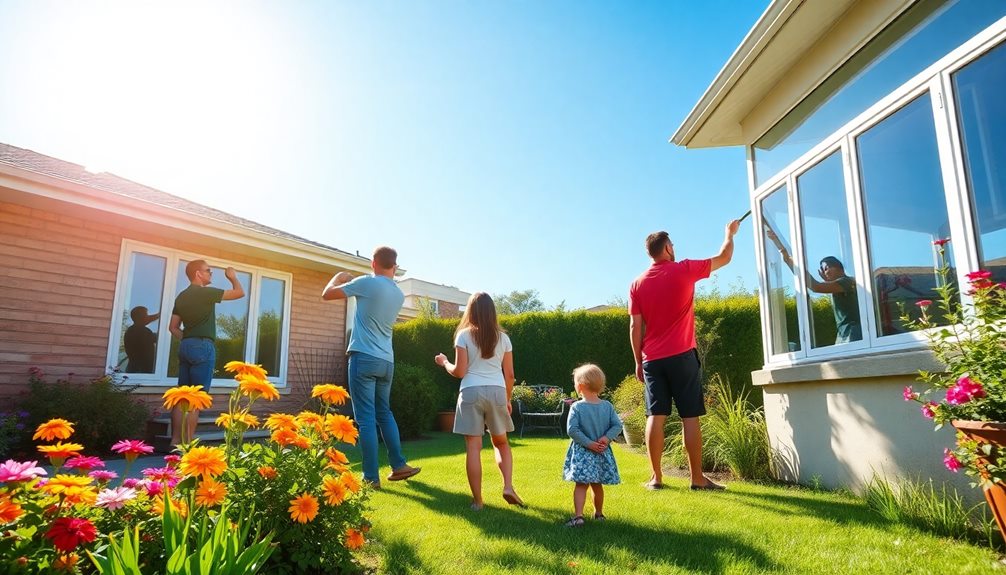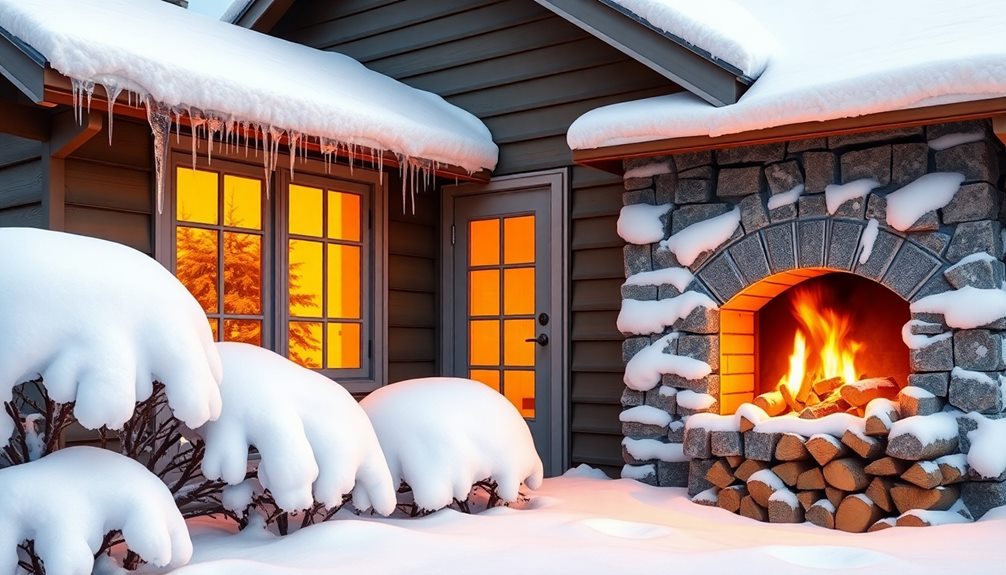To effectively weatherize your home, tackle seasonal tasks throughout the year. In spring, inspect your roof and service your heating system. Come summer, clean your HVAC and seal any gaps around windows. As fall arrives, prepare by checking your furnace and cleaning gutters. During winter, replace furnace filters monthly and insulate exposed pipes. Don't forget to maintain insulation year-round and schedule annual heating system inspections. These steps help improve energy efficiency, reduce heating costs, and enhance comfort. For more detailed tips and an in-depth checklist, you can uncover additional insights on seasonal weatherization strategies.
Key Takeaways
- Inspect and maintain insulation year-round to minimize heat loss and reduce heating costs by up to 20%.
- Clean and service HVAC systems every season to enhance performance and lower energy bills by 10-30%.
- Seal gaps around windows and doors to prevent drafts and save up to $160 annually on heating costs.
- Regularly clean gutters and downspouts to avoid water damage and ice dam formation, especially before winter.
- Schedule annual heating system inspections to ensure efficient operation and reduce energy consumption by 10-20%.
Spring Weatherization Tasks
As spring arrives, it's vital to tackle your weatherization tasks to guarantee your home is ready for the season. Start by inspecting your roof for any signs of wear, such as missing shingles or damage. This is critical for preventing leaks during the spring rain.
Next, check your gutters and downspouts to make certain they're clean and functioning properly. This helps prevent water pooling around your foundation, which can lead to costly repairs.
Don't forget to inspect your windows, too. Repair or replace any damaged screens to keep insects at bay as warmer weather approaches.
While you're at it, check your outdoor faucets for leaks and confirm they're in good working condition.
You should also take a moment to service your heating system; it's easier to do this now than when you need it again in the fall. Replace filters and check for leaks to guarantee the system's efficiency.
Finally, make sure your insulation is intact to keep the cold air out and the warm air in, helping your home stay comfortable.
With these tasks completed, you'll be well-prepared for the spring season.
Summer Maintenance Checklist

Maintaining your home during the summer months is vital for keeping it comfortable and efficient. Start by inspecting and cleaning your HVAC system to guarantee it runs at peak performance. A well-maintained unit can reduce your energy bills by 10-30%, which is especially helpful as you prepare for the winter months.
Additionally, consider the benefits of a heat pump, which can provide both heating and cooling efficiently with minimal environmental impact compared to conventional systems efficient heating and cooling. Don't forget to check and replace the HVAC filters every 1-3 months to maintain air quality and improve airflow.
Next, seal any gaps around windows and doors with caulk or weather stripping to prevent air leaks. This simple step can save you up to 20% on energy costs, making your home more efficient during winter.
It's also important to clean gutters and downspouts to make sure they're clear for summer storms. This prevents water damage and foundation issues, which can lead to costly repairs later.
Fall Preparation Steps

With summer maintenance complete, it's time to shift focus to preparing your home for the fall and winter months. This season is essential for preventing issues that can arise during colder weather.
Effective home insulation is key to maximizing your heating efficiency and comfort, especially if you consider integrating energy-efficient options like commercial grade heat pumps.
Here's a checklist to get you started:
- Clean gutters: Verify gutters and downspouts are clear to prevent ice dam formation, which can lead to roof leaks.
- Inspect furnace filters: Check and replace dirty filters to maintain peak airflow and efficiency. A clean filter can enhance heating effectiveness and reduce energy loss by up to 15%.
- Seal gaps: Look for cracks around windows and doors, and use caulk or weather stripping to seal them. This simple step can save you up to $160 a year on heating costs by minimizing drafts.
- Shut off the water: Drain garden hoses and shut off outdoor spigots to prevent freezing and potential pipe bursts.
Lastly, consider scheduling a professional inspection of your heating system to verify it operates efficiently, preventing unexpected breakdowns during peak winter usage.
Taking these steps now will help keep your home safe and comfortable all season long.
Winter Readiness Actions

Preparing your home for winter is essential to guarantee comfort and safety during the cold months. Start by inspecting and replacing your furnace filters monthly to enhance your heating system's efficiency and keep energy bills low. Seal drafty windows and doors with caulk and weather stripping to help prevent heat loss, which can account for up to 30% of your heating costs.
Next, clean your gutters regularly to avoid ice dams that can cause significant roof damage. Insulate pipes, especially those in unheated areas, to prevent frozen pipes that could burst and lead to costly repairs.
Finally, test your smoke detectors and carbon monoxide alarms. With longer nights during the winter months, ensuring these devices work is critical for your safety.
| Winter Readiness Actions | Importance |
|---|---|
| Inspect Furnace Filters | Boost heating efficiency |
| Seal Drafty Windows | Reduce heat loss |
| Insulate Pipes | Prevent costly damage |
Taking these steps will help keep your home safe and warm throughout the winter. Don't wait; start your winter readiness now!
Year-Round Best Practices

Your home's comfort and energy efficiency depend on consistent upkeep throughout the year. By implementing year-round best practices, you can effectively reduce heating costs and prevent damage.
Regular maintenance of systems like heat pumps can further enhance efficiency and prolong their lifespan, making it essential to understand features of the ultimate heat pump.
Here are four key actions to take:
- Inspect and Maintain Insulation: Regularly check your insulation to minimize heat loss. Inadequate insulation can cause up to 20% of your heating costs.
- Change HVAC Filters: Every three months, replace your HVAC filters. This simple step enhances airflow efficiency and can save you 5-15% on energy bills.
- Seal Drafts: Use caulk or weatherstripping around your windows and doors to seal drafts. Cold air infiltration can account for 30% of your home's heating energy use, so addressing this can markedly improve comfort.
- Clean Gutters and Schedule Inspections: Clean your gutters and downspouts seasonally to prevent ice dams and potential water damage.
Also, schedule annual inspections for your heating system to verify it operates efficiently, which can reduce energy consumption by 10-20%.
Frequently Asked Questions
How Often Should I Perform Weatherization Tasks Each Year?
You should perform weatherization tasks at least twice a year—once in spring and once in fall. This guarantees your home stays energy-efficient and comfortable, helping you save money on heating and cooling throughout the year.
What Tools Do I Need for Home Weatherization?
You'll need a caulking gun, weather stripping, insulation materials, a utility knife, a tape measure, a screwdriver, and safety gear. These tools help you seal drafts, insulate effectively, and guarantee your home stays energy-efficient year-round.
Can I Weatherize My Home Myself, or Should I Hire a Professional?
You can definitely weatherize your home yourself if you're handy and have the right tools. However, hiring a professional might save you time and guarantee everything's done correctly, especially for complex tasks.
How Does Weatherization Affect My Home's Resale Value?
Weatherization's like a warm hug for your home; it boosts energy efficiency and appeal. When potential buyers see reduced energy bills and comfort, they're more likely to pay a premium, enhancing your resale value greatly.
Are There Any Government Incentives for Weatherization Improvements?
Yes, there're government incentives for weatherization improvements. You can access tax credits, rebates, and grants that help reduce costs. Check local programs or the Department of Energy's website to find the best options available for you.
Conclusion
As you shift from the vibrant blooms of spring to the crisp chill of winter, remember that weatherization isn't just about survival; it's about comfort and efficiency year-round. While summer's heat may tempt you to ignore your home's needs, fall's colors remind you to prepare for the cold. Embrace each season's unique challenges, and you'll find that a well-weatherized home not only protects you from the elements but also enhances your living experience throughout the year.









